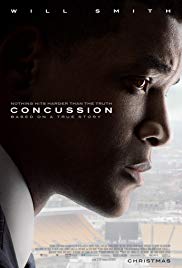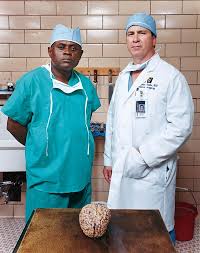After watching the film, engage the class in a discussion about the movie. Here are some suggested questions and good responses.
1. Dr. Omalu and some other parents will not allow their children to play football. Yet, playing football or other contact sports are good experiences for many students. What should a student think about before deciding to sign up to play any contact sport, especially football?
Suggested Response:
There is no one correct answer. Strong discussions will cover the following topics. Benefits of participation include a) enjoyment of playing the game; b) improved strength and conditioning; c) improvement in social status from being on the team; d) an outlet for aggression; and e) learning to work with a team and character-building (if the coaches are true educators and not primarily interested in winning). Detriments include a) risk of injury – how serious, how long-lasting, how frequent, and what resources are available for medical care; and b) diversion from schoolwork which is the only way to economic security for the vast majority of students. Other considerations are whether for the particular team, the league, and the sport as a whole, the adults, the coaches, and those in charge act in ways that are beneficial to the students/players. There are two questions on this topic: first, whether those in control act with character and teach sportsmanship, honesty, and obedience to the rules, or whether they are focused on winning at all costs. The second is whether those in control are focused on benefits to the players as opposed to their own benefits or the institutional benefits that success on the playing field will bring. Unless the student is one of the infinitesimal group of athletes who have a chance at a professional career, doing well in academics is the best way to economic success and security.
2. Dr. Julian Bailes, neurosurgeon and concussion researcher, who became Dr. Omalu’s partner in the effort to reduce repetitive head trauma in football asked the NFL, “Why don’t you take the head out of the game? Just take it out of the game! Let the linemen start from a squatting position instead of getting down for head-to-head. Have them stand up like they do on pass protection. So there’s not this obligatory head contact.” The NFL has never responded to this suggestion nor have they changed the rules as Dr. Bailes suggested. NFL play still has the “head in the game.” Answer two questions:
- Why are the heads of football players still “in the game?” and
- It is said that the brutality of football is necessary to satisfy the blood lust of the fans. Do you think that this is a valid reason for keeping the players’ “heads in the game?”
Suggested Response:
(a) The NFL believes that the fans want a game with “head in it” and the NFL has a financial interest in keeping its fans happy.
(b) People differ on the answer to this question. There are “sports” that would not exist if the blood-lust component was removed, such as boxing, professional wrestling, and various martial arts competitions. Many people refuse to watch these spectacles because they don’t like violence. However, in football, the most beautiful and exciting moments come without head-to-head contact such as when a receiver catches a pass or a runner breaks away for a long gain. It can be argued that the reliance on the three-point stance (feet and one hand on the ground, which requires the head to be down) and the head-to-head combat is not essential for football.
Concussion and CTE
3. What are the biomechanics of a concussion?
Suggested Response:
Concussion results from a rapid change in the velocity of the head. The brain essentially sloshes around in fluid within the skull. When the skull stops suddenly, the brain continues on until it smashes up against the inside of the skull. Depending on the amount of force involved, this causes injury to the brain tissue and internal bleeding. Even one concussion or repeated low-level impacts to the head can cause brain injury.
4. What is “second impact syndrome?”
Suggested Response:
When a person gets a second concussion before a first concussion is allowed to fully heal, the effect of a second concussion is much worse than the level of impact would normally cause.
5. The brain is 75 to 80% water. In that watery form float 300 billion nerve cells. How are they attached to each other and what does a shearing injury due to the structures that attach the nerves to each other?
Suggested Response:
The cells are attached to each other and supported by membranes and micro skeletons made of certain types of proteins, including tau proteins. A rotational or shearing injury rips these membranes.
6. Not all football players develop early-onset dementia. Does this mean that concussions or repeated head trauma are not a causal factor in the development of CTE and that there is no need to reduce repeated head trauma in football?
Suggested Response:
It means that head trauma combined with some other factors such as drug use, genetic predisposition, or some other factor causes the injury. We don’t know what those other factors are. The factor that we can control is repeated trauma to the head which means that until we can discover what those other factors are, head trauma should be reduced, and the head should be taken out of the game.
7. What is the argument for the contention that the rigid plastic helmets introduced into football in the 1940s led to additional concussions and repeated lower-level brain trauma?
Suggested Response:
By preventing direct injuries to the head and skull the new helmets made it possible to tackle with the head. It made football players more confident that they are protected from head injury. This can give a player a false sense of confidence and encourage him to lead with his head, increasing the cumulative number of situations in which the head is suddenly stopped and the brain is pushed up against the skull. Omalu pp. 9, 70 & 71;
Other Questions
8. Should we look to the NFL for leadership in the protection of the health of football players?
Suggested Response:
As to the first question: Experience tells us that we should not rely on the NFL to protect its players. Many of the NFL’s actions relating to concussion injury and the high rates of dementia among retired football players demonstrate that the NFL has trouble motivating itself to protect the health of its players. For example, the players were forced to sue the NFL for just compensation for CTE. Mike Webster’s family was forced to the sue the NFL for disability payments.
9. Does the NFL have a responsibility to investigate whether CTE is caused by playing football, report its findings to its players, and take remedial action to take the head out of the game if there is evidence that CTE is caused by playing football?
Suggested Response:
The argument against responsibility by the league is that the players know that football is dangerous and they are well-paid for their work. On the other hand, basic fairness would dictate that when the league is making money on the performances of its players it has a duty to actively investigate the link between CTE and playing football, report its findings and take effective remedial action. The league has many more resources than any one player and access to more information on the situation.
9. Ultimately, who is responsible for the violence in football?
Suggested Response:
The fans. The people who make money from the game are also responsible. The players too bear some responsibility, because now they know some of the risks and they voluntarily play the game. However, the main driver for violence in football are the fans. With respect to violence in football, “We have seen the enemy and he is us.” A good discussion of this question will raise the issue of why many fans love the violence inherent in football.
10. What motivates football players to knowingly risk their health to play the game. Answer for high school, college, and professional players.
Suggested Response:
For all levels, it is the glory and prestige of being a star athlete. For many, it is the love of the game. In college, one can add the slight possibility of making it in the NFL. For NFL players the money is also a major factor because they have to provide for their families.
11. Are there any other sports whose players are at risk for concussion injury? If so, name them. Do you think the risk is as great as in American football?
Suggested Response:
These include hockey, soccer (called football everywhere except the U.S.), rugby. There could be more.
12. This film came out in 2015 and was very popular. It started a debate throughout the U.S. about whether football was a safe sport for young people to play. There were dire predictions that youth football would collapse if just 10% of U.S. mothers kept their children from playing football. However, youth sports are still going strong while the evidence that CTE is caused by concussion injury has only increased. Develop a theory to explain this phenomenon.
Suggested Response:
Any good discussion of this question will raise the issue of motivated blindness and the normalcy bias. See discussion at Section on Motivated Blindness and the Normalcy Bias in the Learning Guide to the film Cowspiracy.







